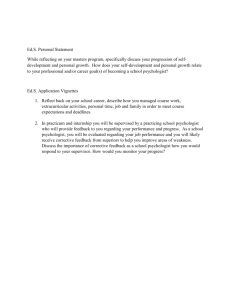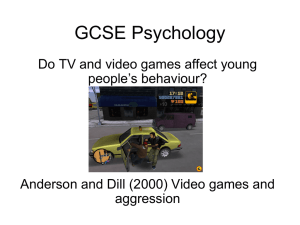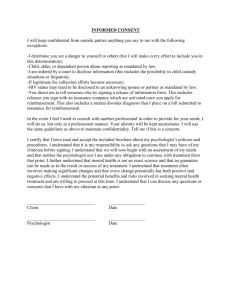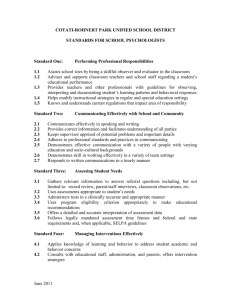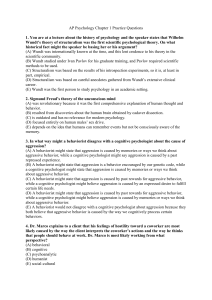Quiz- Revision lesson One
advertisement
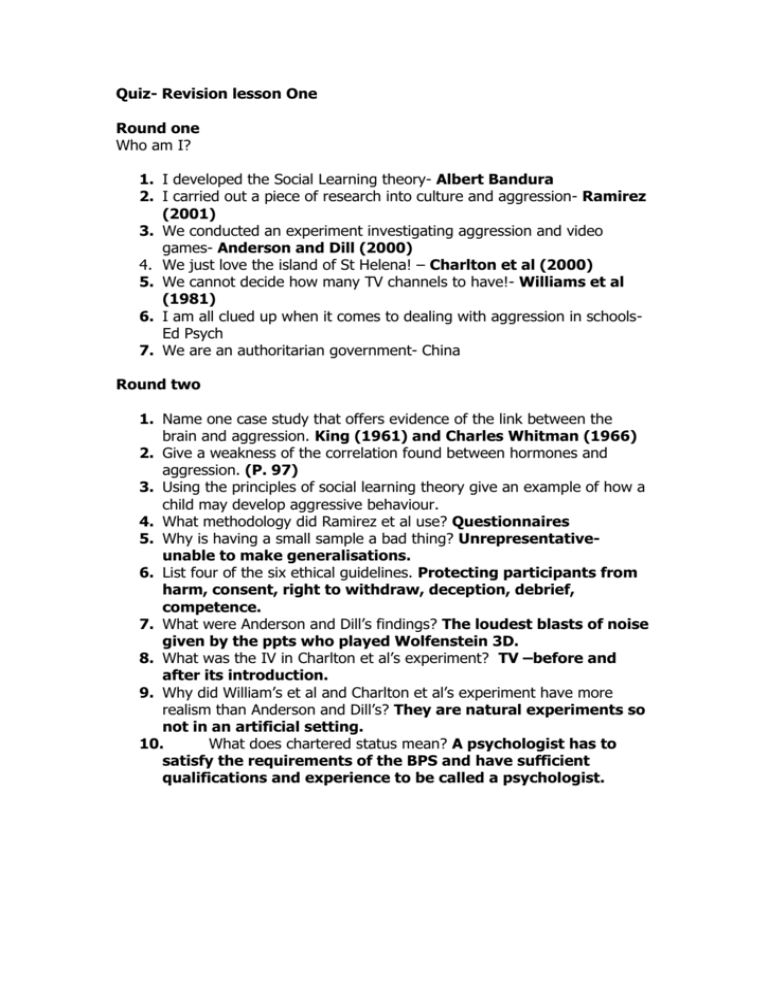
Quiz- Revision lesson One Round one Who am I? 1. I developed the Social Learning theory- Albert Bandura 2. I carried out a piece of research into culture and aggression- Ramirez (2001) 3. We conducted an experiment investigating aggression and video games- Anderson and Dill (2000) 4. We just love the island of St Helena! – Charlton et al (2000) 5. We cannot decide how many TV channels to have!- Williams et al (1981) 6. I am all clued up when it comes to dealing with aggression in schoolsEd Psych 7. We are an authoritarian government- China Round two 1. Name one case study that offers evidence of the link between the brain and aggression. King (1961) and Charles Whitman (1966) 2. Give a weakness of the correlation found between hormones and aggression. (P. 97) 3. Using the principles of social learning theory give an example of how a child may develop aggressive behaviour. 4. What methodology did Ramirez et al use? Questionnaires 5. Why is having a small sample a bad thing? Unrepresentativeunable to make generalisations. 6. List four of the six ethical guidelines. Protecting participants from harm, consent, right to withdraw, deception, debrief, competence. 7. What were Anderson and Dill’s findings? The loudest blasts of noise given by the ppts who played Wolfenstein 3D. 8. What was the IV in Charlton et al’s experiment? TV –before and after its introduction. 9. Why did William’s et al and Charlton et al’s experiment have more realism than Anderson and Dill’s? They are natural experiments so not in an artificial setting. 10. What does chartered status mean? A psychologist has to satisfy the requirements of the BPS and have sufficient qualifications and experience to be called a psychologist. Quiz- Revision lesson Two Round one 1. I just love messing around with dogs! – Pavlov 2. They made me scared of all white fluffy things!!!- Little Albert 3. I tried to use the principles of classical conditioning to unlearn Peter’s phobia- Jones (1924) 4. We asked loads of questions about animals- Bennett- Levy and Marteau (1984) 5. I treat people who suffer with phobia- clinical psychologist 6. We researched cultural differences in fear- Henrichs et al (2005) 7. I freaked out monkeys in a laboratory experiment- Mineka (1984) 8. I managed to fool a blackbird- Curio (1988) Round two 1. 2. 3. 4. 5. 6. Using the correct terms, explain Little Albert’s fear of the rat. Give an example of vicarious reinforcement. How might our ancestors have an influence on fears we have today? Give an example of a rank-style and Likert scale question. What is a negative evaluation point of questionnaires? (P141) List three of the ethical issues that need to be considered when experimenting with animals. Causing pain and fear, social isolation, numbers of animals, choice of species. 7. What techniques did Jones use to cure Peter of his phobia? Deconditioning (systematic desensitisation) and social learning theory (modelling). 8. What did Bennett- Levy and Marteau question the participants on? Their fear of animals that moved quickly, move suddenly or looked different from people. 9. Give an example of a hierarchy of fear. 10. List three of the treatments used to overcome phobias. Systematic desensitisation, CBT, Exposure based CBT, Hypnotherapy, and psychodynamic therapies. Quiz- Revision lesson three Round one 1. I investigated the link between adopted twins and aggressionMednick (1984) 2. I also investigated twins but in Denmark- Christiansen (1977) 3. I believe maternal deprivation causes criminality- John Bowlby (1946) 4. We carried out a natural experiment in a school, investigating the self fulfilling prophecy- Rosenthal and Jacobsen (1968) 5. I discovered the names of the week can affect behaviour- Gustav Jahoda (1954) 6. I conducted an pointless piece of research into chromosome abnormality- Theilgaard (1984) 7. We discovered that attractiveness wins over the jury- Sigall and Ostrove (1975) 8. I found out that it is down to parent’s expectations of their children that causes children to drink alcohol- Madon (2004) 9. I was wrongfully accused of Rachel Nickell’s murder- Colin Stagg 10. I was the criminal profiler on Rachel Nickell and John Duffy case- Robert Canter 11. I help to convict and treat criminals- Forensic psychologist Round two 1. List three of the social explanations for criminality. Divorce, maternal deprivation, family size, parental occupation. (3) 2. What are the three types of childrearing styles? Induction, love withdrawal, power assertion. (3) 3. List two ethical and two practical problems of gathering information from convicted offenders. (P.184) (4) 4. List three key bits of information that make up a criminal profile. Sex of offender, race, age, marital status, occupation, intellectual ability, possible criminal history and area the criminal lives in. (3) 5. Give two ways in which Robert Canter’s profile of John Duffy matched the facts about Duffy. (P.189) (2) 6. Briefly explain personal construct therapy. Identifying similar characteristics of two people and one person that is different; caring not caring, good- bad. The therapy aims to show progress of individual using the personal constructs as a benchmark to change. (2) 7. What three main characteristics affect the jury decision-making process? Race, attractiveness and accent of defendant. (3) 8. Why is there not a definite conclusion as to whether biological or social factors cause criminality? (2) 9. How is CBT used to treat sex offenders? Inappropriate thinking, or lack of social skills, change the way a person thinks to help alter behaviour. (2) 10. How can a forensic psychologist be involved in the convicting and treating of prisoners? Offender profiling, setting up treatment programmes and implementing them. (3)
